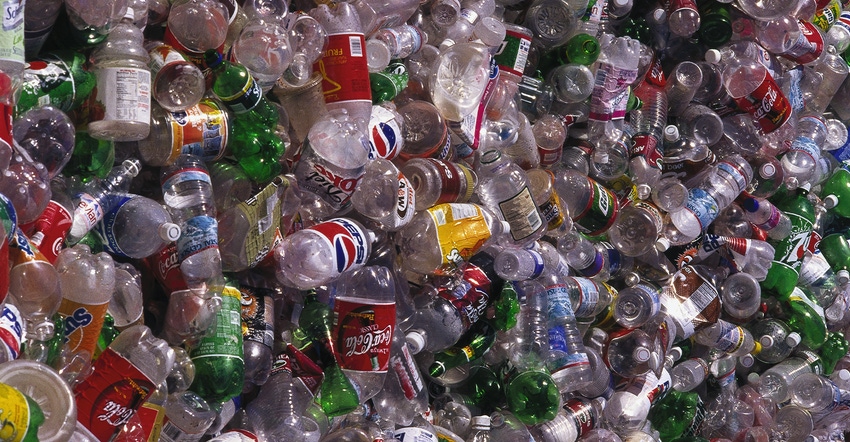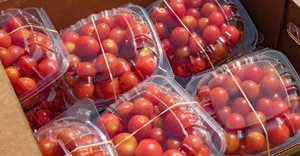The Royal Statistical Society (RSS) in England announced in December 2018 that the winning International Statistic of the year was 90.5%. This number represents the proportion of plastic waste that had never been recycled based on a paper titled, “Production, use, and fate of all plastics ever made.” RSS executive director Hetan Shah stated that the statistics captured the zeitgeist of 2018. If anything, the statistic on plastic appears to have captured an ever-increasing concern about plastic waste.

The Royal Statistical Society (RSS) in England announced in December 2018 that the winning International Statistic of the year was 90.5%. This number represents the proportion of plastic waste that had never been recycled based on a paper titled, “Production, use, and fate of all plastics ever made.” RSS executive director Hetan Shah stated that the statistics captured the zeitgeist of 2018. If anything, the statistic on plastic appears to have captured an ever-increasing concern about plastic waste.
Only 9.5% was recycled?
This global figure is poorly understood. It does not distinguish between countries. Despite that, the current U.S. plastic recycling number is coincidentally close to the 9%. The global figure also does not distinguish between types of plastic --- whether it’s a plastic beverage bottle or a cell phone case or a bike helmet. Instead, it is a calculation of all plastic that has been generated since 1950, or 8300 million metric tons (Mt). From that number, it subtracts the amount that is still in use, or 2500 Mt as well the amount that was were discarded or incinerated, or 5700 Mt. It also states that about 600 Mt were recycled.
At first glance, the numbers do not add up. If a total of 8300 Mt generated and 5700 Mt was discarded or incinerated and 2500 Mt is still in use, that only leaves 100 Mt unaccounted for, not 600 Mt. This discrepancy can be explained because plastics cannot be recycled endlessly. Depending on the source, plastic can be recycled as many as ten times or as few as 2-3 times. Of the 600 Mt of plastic that was ever recycled, most of it has since been discarded or incinerated.
Further, most plastic packaging is not recycled into the same product. For example, in the U.S., only a small amount of PET is recycled into food and beverage bottles. The primary end market is fiber. Similarly, less than half of HDPE is recycled into bottles. Pipe, lumber, lawn/garden and other outlets take the remainder of the recycled HDPE. Given that, while still conserving resources, much of plastic recycling is not circular.
What is plastic waste in the U.S.?
More recent reporting questions whether recycling is even at 9%. The Last Beach Cleanup estimated that 5-6% of plastic is recycled. Given that the public wants to recycle more packaging, this figure can be disheartening. However, it should be put into context because plastic is more than just packaging and yet most people only think about packaging.
Of plastic wastes, about 38% was in durable goods. EPA defines durable good as products with a lifetime of three years or more. This includes items such as appliances, furniture, carpets, consumer electronics, sports equipment and luggage.
Another 21% was in nondurable goods. Nondurable goods are products with a lifetime less than three years – but not packaging. Nondurable goods includes plastic plates, cups and cutlery; disposable diapers; clothing and footwear; and trash bags. Disposable diapers and trash bags are unlikely to be recycled anytime soon. In looking at textiles, EPA found that significant amounts were reused but those numbers were not included in either the generation of waste or the recycling figures.
The last 40% of plastic waste was containers and packaging. Containers and packaging is what we generally consider to be recyclables. The container and packaging recycling rate is higher at 13.6% according to the EPA with PET and natural HDPE bottles topping the recycling rate at about 29%.
Is it recyclable?
While plastic bottles are almost always recyclable in the curbside bin, confusion stems from messaging about other plastics. The public is often directly to their local municipality to obtain information about what can be recycled. The following chart shows what the largest cities in the U.S. accept.
| Bottles & jars | Rigid caps & lids | Rigid plastic food containers | Rigid plastic non-food containers | Rigid plastic house-wares | Bulk rigid plastics |
X | X | X | X | X | X | |
X | X | X | X |
|
| |
X |
| X | X |
|
| |
X | X | X | X |
|
| |
X | X | X | X |
|
| |
X | X | X | X |
|
|
But given the limited attention spans, most people access recycling information from labels on packaging. Unfortunately, the recycling symbol, characterized by a triangle of chasing arrows, which is useful for paper and cans instead causes additional confusion with plastic. Rather than using the recycling symbol to indicate that a material is recyclable, plastic packaging uses a resin identification code (RIC) with numbers ranging from one to seven. Because the public understands the recycling symbol for paper and cans, they often mistakenly assume that the symbol indicates that the packaging can be recycled in their curbside bin.
However, eliminating the RIC from plastic packaging is not easy. Many states require the RIC to be on packaging. This is slowly changing with Washington, Oregon and California changing requirements in 2021.
Plastics in the environment
Part of the reason for plastic waste representing the zeitgeist of our time is that people are disturbed by how frequently plastic is found in the environment and the attendant harm it may cause. Twenty years ago, Bangladesh became the first country to ban single use plastic bags after they were found to exacerbate flooding by clogging up the drainage infrastructure. South Africa, where the plastic bag was facetiously dubbed the “national flower,” quickly followed. In total, 94 countries now have plastic bag bans and another 54 have imposed taxes, partial bans or other restrictions on plastic bags.
A significant portion of the plastic that is improperly managed can make its way into the ocean. Reports suggest that up to 2.75 Mt of plastic waste is dumped into the oceans annually from rivers around the world with eight rivers in Asia and two in Africa representing 93% of the total.
Awareness of plastic in the marine environment continues to rise. In 2009, Oprah Winfrey hosted Fabien Cousteau, grandson of the famed ocean explorer, Jacques Cousteau discussing the great Pacific garbage patch, formed by ocean currents, consisting mainly of plastic debris. And Blue Planet II, narrated by David Attenborough, highlighted the problems with ocean debris showing animals directly affected by exposure to plastics.
Compared to other materials, plastic is the primary material in the environment. According to the Ocean Conversancy’s beach cleanup data for 2020, plastic makes up the vast majority of material taking up seven of the top ten spots. Plastic grocery bags takes the 6th spot and straws and stirrers, a frequently banned item, takes the 7th spot. Plastic beverage bottles (#2) and plastic bottles caps (#5) would exceed cigarette butts (#1) if taken together. Seeing plastic in the environment triggers outrage in the public and a strong desire to rectify the situation.
And increasingly, the public is finding out that what goes around comes around. Research indicates that people are consuming up to five grams of microplastics each week through water, shellfish, beer, salt and other foods. This has been compared to ingesting approximately a credit card’s worth of plastic every week.
Plastic exports
Many of the countries that contribute to ocean plastics were destinations for plastic recyclables from the U.S. Given that processing recyclables is anticipated to result in some material loss, concerns rose that this material could enter the environment. Environmental organizations pressured U.S. waste management companies to stop exporting plastics recyclables. Most made commitments to end plastic exports from North America. However, Canada and Mexico are still common destinations.
Looking beyond recycling
Manufacturers select plastic packaging over other materials for a variety of reasons. Plastic is flexible and lightweight and inexpensive. These factors may provide environmental benefits that are more important than recycling. Environmental factors include such things as climate change implications, acidification, and water consumption.
In 2020, Sphera conducted a life cycle analysis for Ball Corporation of common beverage containers to evaluate which had the best environmental footprint. In comparing multiple environmental impacts, the non-carbonated PET bottle had the lowest impact. Should these factors outweigh recycling when considering packaging?
What is the solution to preventing plastics from entering the environment?
To protect the environment, a multi-prong approach is necessary to deal with plastics. Recycling alone cannot prevent plastics from entering the environment. And keeping plastics out of the environment is more important than recycling.
Just like with plastic bag bans, many organizations are reconsidering the necessity of plastic products. The U.S. Plastics Pact developed a list of problematic and unnecessary materials which members have committed to take measures to eliminate by 2025. These include non-reusable, non-recyclable, non-compostable plastic cutlery, stirrers and straws, PVC, polystyrene, black plastics and plastics with PFAS.
For plastics that continue to be made, efforts can be focused on making plastic recycling more circular. Minimum content mandates for plastic packaging helps maintain the circularity of the material. California’s AB793 from 2020 does this in a tiered fashion starting this year with a 15% requirement. In 2025, the requirement jumps to 25% and in 2030, it jumps again to 50%. Similarly, New Jersey’s new minimum content law passed earlier this year requiring recycled content of 10% by 2024. And earlier this year, the Northeast Recycling Council (NERC) shared a draft model legislation for minimum content. These efforts will increase demand, pulling recyclable plastic into circularity, rather than the alternative markets that are currently prevalent.
But recycling, by itself, cannot fix the issues. As noted, even if recycled, plastic cannot be endlessly recycled. When it reaches its end of life, it will need to be managed appropriately to keep it out of the environment. Environmentally sound solid waste management systems need to be supported to ensure the protection of our oceans and ecology. Until the other 90.5% of plastics can be recycled, waste-to-energy and landfills are necessary to protect our oceans.
About the Author(s)
You May Also Like


